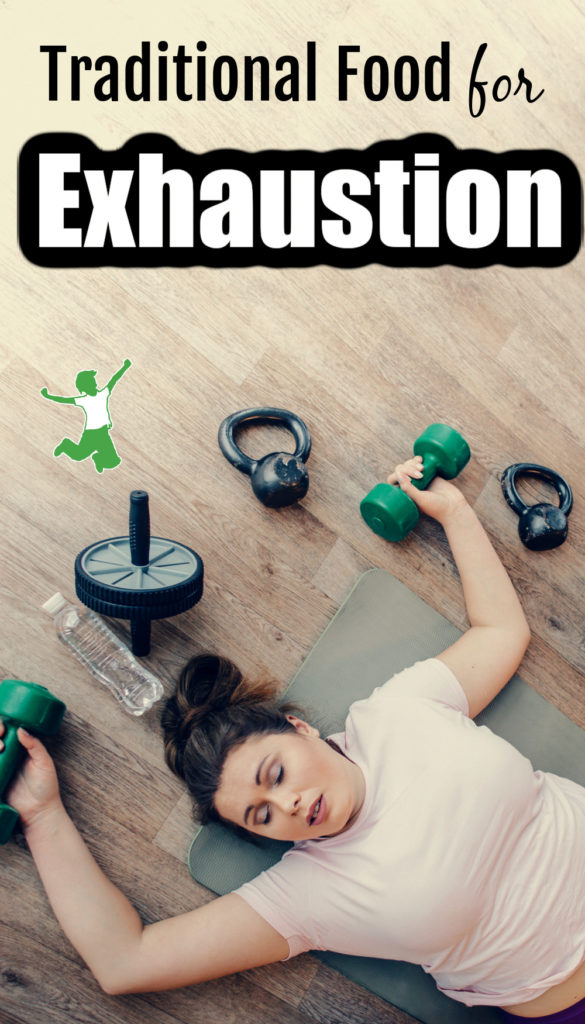Table of Contents[Hide][Show]
The traditional food used to remedy exhaustion in healthy, ancestral societies, the research that supports this superfood in the diet and easy ways to get it on the home menu in a convenient and budget-friendly manner.

Energy drinks are the new norm in our exhausted society today. A mind-boggling array of cans or shots are available at gas stations, supermarkets, and health food stores alike.
These beverages are frequently marketed as nutritional supplements, which removes the limit to the amount of caffeine they can contain.
Some brands contain such excessive levels of caffeine that people have ended up in the ER after consuming them.
Some parents are resorting to energy drinks for their exhausted young children on the way to school or athletic events!
Exhausted and stressed college students take it to the next level.
Illegal procurement and abuse of the ADHD drug Adderall helps them stay awake to study and gives them an “edge”.
The Journal of Medical Internet Research produced two major revelations in its six-month study of Adderall:
- It is mentioned most heavily among students in the northeast and south regions of the U.S.
- Tweets about Adderall peak sharply during final exam periods.
Lead researcher Carl Hanson, Professor of health science at BYU, had this to say:
“Adderall is the most commonly abused prescription stimulant among college students. Our concern is that the more it becomes a social norm in online conversation, the higher risk there is of more people abusing it.”
Why Are People So Exhausted?
Seesawing blood sugar from the modern diet loaded with sugar-laden, highly refined carbohydrate foods is no doubt part of the problem. Dr. Ronald Hoffman MD, author of Intelligent Medicine, writes:
Americans love to “carbo-load.” We are a society in love with carbohydrates — and it shows in our poor health standing versus some of the other industrialized nations of the world. In essence, hypoglycemia is low blood sugar, and it is increasingly prevalent in our society. Hypoglycemia can cause an array of symptoms, including dizziness, fatigue, mood changes, PMS, sugar craving, headaches, difficulty concentrating, tremors, temperamental outbursts, depression, excessive sweating, hot flashes, palpitations, cold extremities, abdominal pain, and panic attacks.
While a return to a whole diet where traditional fats are embraced and refined carbs and sugar are kept to a minimum no doubt helps resolve many issues with exhaustion, even those who eat an excellent Traditional Diet and follow a healthful exercise regimen can still suffer from occasional to extended bouts of fatigue.
A friend of mine recently came to me with this exact scenario. A healthy Mom of normal weight who has been eating an excellent Traditional Diet with plenty of blood sugar-stabilizing, healthy fats for years and exercises regularly confessed that she was exhausted and couldn’t figure out why.
Traditional Food for Exhaustion
What to do in those situations?
If the blood sugar is steady and a traditional diet is being followed, are coffee, energy drinks, or some other form of artificial stimulant the only options to get oneself off the couch?
Absolutely not!
When exhaustion is sucking the life out of one’s life, the tried and true remedy is plentiful quantities of liver, the planet’s #1 superfood, known for its mysterious and legendary anti-fatigue factor which science has yet to identify.
A July 1951 article published in the Proceedings of the Society for Experimental Biology and Medicine describes this factor and a study that attempted to identify it.
Benjamin K. Ershoff, Ph.D. divided lab rats into three groups.
- The first group of rats ate a basic rat diet, fortified with 11 vitamins.
- Group 2 ate the same rat diet as group 1, with the addition of supplemental vitamin B complex.
- Group 3 ate the same rat diet as the first two groups but instead of vitamins or B complex, they received 10% of their ration as powdered liver.
Anti-Fatigue Factor
The results of this unique experiment?
A 1975 article in Prevention magazine described the results of the experiment in the following words:
“After several weeks, the animals were placed one by one into a drum of cold water from which they could not climb out. They literally were forced to sink or swim. Rats in the first group swam for an average 13.3 minutes before giving up. The second group, which had the added fortifications of B vitamins, swam for an average of 13.4 minutes. Of the last group of rats, the ones receiving liver, three swam for 63, 83 and 87 minutes. The other nine rats in this group were still swimming vigorously at the end of two hours when the test was terminated. Something in the liver had prevented them from becoming exhausted. To this day scientists have not been able to pin a label on this anti-fatigue factor.”
Exhaustion Post-Covid
Knowing about the above research for many years, I applied it to resolve my fatigue after our family’s bout with Covid in the summer of 2021.
I consumed 6 capsules of desiccated liver powder (equates to roughly 1/2 ounce of fresh liver) every day for a few weeks.
Fatigue was completely resolved in short order and my previous strength levels returned!
But Wait! What About the Cholesterol!
A common objection to frequent consumption of liver is the high amount of cholesterol.
The truth is that numerous studies show no relationship between diet and cholesterol levels.
In addition, there is no evidence that saturated fat and cholesterol-rich foods like liver contribute to heart disease.
In fact, as Americans have cut back on cholesterol-rich foods in recent decades, rates of heart disease have actually gone up! This is according to Dr. Uffe Ravnskov, MD, Ph.D., author of The Cholesterol Myths.
5 Easy Ways to Eat Liver (even if you hate it)
Should we all wait until science identifies liver’s legendary anti-fatigue factor or start benefiting from this superfood’s ability to raise the exhausted and fatigued of the world off the couch and back into the game of life right away?
Have no fear. Here are several ways to eat liver that are either painless or flat-out delicious. I personally eat a minimum of 4-6 ounces of liver each and every week – many weeks much more than this amount as needed.
Liver and Bacon pate
If strong-tasting beef liver and onions turn your stomach as it does mine, try my recipe for milder tasting liver pate made with chicken livers and bacon that is an excellent dip or spread on toast.
This inclusion of bacon pureed with the liver makes the flavor well accepted even by children.
Liver and rice
Just before you put a pot of soaked rice on to cook, mix in one or two spoonfuls of grated liver.
The liver will impart a wonderful flavor to the cooked rice and your family won’t know the difference.
Note that brown rice works better than white rice for this trick.
Frozen liver “pills”
Chop up raw, grass-fed liver that has been frozen for 14 days or more (eliminates parasite risk) into small pieces. Then, swallow a few each day whole with a glass of water, milk, or juice.
Over the span of a week, you will consume several ounces and no doubt be feeling much more energetic.
Desiccated liver powder
Perhaps the easiest and most convenient way to get your liver is through a freeze-dried, grass-fed, desiccated liver supplement.
I use this when we haven’t been eating enough pate or I’m out of liver to mix with ground beef.
You can take the powder in capsule form or sprinkle it into homemade soups and sauces for a boost of nutrition.
This brand and this brand are clean and tested to be glyphosate-free.
Hide Liver in Ground Beef
An easy way to get liver into your family is to hide it in the ground beef you will use for making burgers or dishes like grassfed meatloaf.
The trick is to keep the amount of ground liver you use small so that no one can taste it. I suggest no more than 20%. For those with very keen taste buds, 10% is better.
Anecdotal Evidence
Will liver really work for you to eliminate exhaustion and fatigue problems? It worked for my friend mentioned earlier in the article.
After I suggested that she start eating liver, she went home and started eating it several times a week.
The next time I asked her about it a few weeks later, she reported that she felt so much better and was experiencing normal energy levels once again.
Will it work for you too? What have you honestly got to lose? Humans have eaten and revered liver as a sacred superfood for millennia.
If you’ve never eaten it, why not try it now?
References
Adderall use as college study aid ‘trending’ on East Coast
Monster Energy Drinks Killed 5 People: Report
Hypoglycemia
Nourishing Traditions
Myths and Truths about Cholesterol
The Liver Files









I finally spent a bunch of money on adding supplements to our family’s diet – fermented cod liver oil, natural vitamin C, making milk kefir for the probiotic boost, and gelatin. When is enough, enough? If eating a traditional food diet, with lots of butter, coconut oil, raw milk, grass fed beef, and free range eggs, plus more of the good stuff – how much supplementation is necessary?
Sarah, how many supplements do you take a day in addition to what you eat?
It sounds like you’re doing great – better than the majority of people today. We can only do what we can do with all of this information. I’m not in a big hurry to go get quality liver to add into my diet, but at some point I might if I can locate a quality source. Fatigue can be due to numerous other causes, not always a lack of liver and the nutrients it provides. I don’t want to get OCD about all of this, though I want to try to do as much to eat and live as healthily as possible and I am grateful to have the information and ideas/opinions to sort out and figure out what will work for me.
Thanks Jen! I definitely needed a little reassurance to take it slow – incorporate what we’ve already got and go from there.
Baby steps 🙂
We are stuck with needing so many supps today, because of how degenerated humans are now. Find what works for you!
I have often wondered if I could make a broth from pastured liver and just drink the broth? Would I still get the nutrients that way? I’ve tried the frozen liver pill method and the shaved liver method and I still find the irony taste too much (even after soaking in lemon juice). But my freezer is full of liver just waiting for me!
HELP, Sarah, please. 🙂
Make a pureed style pate, and make sure the spice mix is on the high side. I love liver pate that way, but cannot stand it any other way.
Thank you Sarah! This article has come at just the right time for me. My family eats a WAPF diet, but my husband still has low energy. He felt good yesterday — and I realized after reading your article that it’s probably because our dinner from the night before contained liver! I’m going to give him liver every day for a couple weeks to see if his energy will improve. I expect it will!
Sarah,
Thank you so much. I had forgotten how amazing liver is. Once I read your article I cooked up some rare liver, and ate it straight. YUM!
How many chicken livers would I need to eat, to achieve a daily or weekly dose?
Thanks for the excellent blog, you are a great inspiration to me 🙂
Hi Sarah,
Thanks for the article. What type of liver is the best to eat and what would be your top 3 choices?
Thanks,
Angelo
Different types of liver offer a varying mix of macro and trace nutrients. Best to mix it up if you can.
Thanks Sarah.
Do you have a top 3 of liver sources types?
Angelo
I am just curious…does it matter what kind of liver? I can get chicken, beef, pork, or lamb liver and just wonder if one might be better than another. All are from local farms.
If you have access to all these different types of liver .. then rotate them around and eat them all! What a fortunate situation you have! I don’t think you can classify one type of liver as “best” .. they are all incredible and gram for gram the most nutrient dense food on the planet.
Sarah,
When I was a kid I ate lots of liverwurst andonion sandwiches. How does liverwurst compare to liver, which I avoid? It liverwurst a viable source of the ‘good stuff’ in liver?
Love the liverwurst! Just find a quality one without additives. I’ve actually seen good ones from time to time at SuperTarget.
Sarah, do you recall the brand of the additive-free liverwurst at Target? I’d also be curious to know if it’s properly raised without antibiotics, hormones and other toxins.
Which reminds me, an alert went out yesterday from the Organic Consumers Association regarding Target because they are a dues-paying member of the group that is bank-rolling the efforts to defeat GMO labeling laws in any state, and they carry products containing unlabeled GMOs without putting any pressure on manufacturers to label them or placing labels in their stores.
Hey Sarah,
Can you please recommend a good source of desiccated liver powder, if someone is unable to make their own or access good quality, fresh liver? I’ve reviewed several sold on Amazon, but I’m confused on which one is best. Many are defatted, but I assume we want the fat so that we can consume the vitamins A, K and D. Thanks for the help and all you do in educating others! I cherish your blogs!
Radiant Life is a very good company you can trust that has a desiccated, additive-free, grass-fed liver product. I’ve used it, but since I like liver, I don’t take the desiccated liver very often. I have it on hand for when I’m out of liver.
I have been considering supplementing with raw, grass-fed liver capsules as a means to improve my anemia. I am currently taking conventional iron supplements (675mg) and wish to transition to a more food-based form of iron supplementation. I am also considering taking a supplement of powdered greens. What are your thoughts on supplements such as Vitamineral Green? Ingredients are listed below.
From the Landâ„¢
Nettle Leaf°âˆž, Juices:, Alfalfa Grassװ, Barley Grassװ, Dandelion Leafװ, Oat Grassװ, American Basilװ, Amla Berry°âˆž, Barley Grassװ, Carob Pod°âˆž, Chickweed°âˆž, Ginger Rootװ, Holy Basil/Tulsi°âˆž, Horsetail/Shavegrass°âˆž, Moringa Leaf°âˆž, Parsley Leafװ, Shilajit °âˆž, Wheat Grassװ, Yacon Leaf°âˆž
From the Watersâ„¢
Chlorella◊, Spirulina∞
From the Oceansâ„¢ â—Š°âˆž
Alaria, Bladderwrack, Kelp, Dulse, Lavar, Nori
Vitamineral Green™ Enzyme Concentrate∞
Protease, Amylase, Lipase, Cellulase, Bromelain, Papain, Alpha-Galactosidase
Vitamineral Green™ Friendly Force™ Probiotics∞
Acid stable, shelf stable, colonizing (NOT transient), truly Vegan and incredibly magnified/fed by the Vitamineral Greenâ„¢ formula. L. plantarum, L. paracasei, L. rhamnosus, L. salivarius, S. thermophilus, L. bulgaricus, 10,000,000,000 per serving THROUGH EXPIRATION DATE!
Question about the raw liver: I have some in my freezer that I’ve had for a few months. The farm says it should still be okay. I’m wondering about how it works with cutting it into pieces to swallow like pills: am I supposed to thaw them to cut (obviously I can’t cut them frozen) and then re-freeze for two weeks? Is that safe?
Just cut off a bit while its still frozen and chop the bit you cut off into little pieces. The little raw liver pills are actually easier to swallow when frozen anyway. No need to thaw the liver first.
You’re right Sarah. You don’t need to thaw the liver prior to cutting – actually it’s easier to cut if it is not thawed completely. While still frozen, I make shaved liver using a slicer and put it into my scrambled eggs or omelet. It tastes great.
Wonderful tip! Thanks for sharing!
Since I’m allergic to PABA, I was told to stay away from liver. Is that true?
If your practitioner is conventional, I would seek a second opinion about that. I would recommend a phone or Skype consult with one of the staff at Biodynamicwellness.com (San Diego area).
Thanks!
Hi Sarah, I thought this post was insightful. I read a previous post, however, that was quite disturbing. The one about green smoothies being “devastating” to health, and your blanket recommendation that EVERYONE should avoid them. I think that it is good to not over-consume just about anything.. but maybe you should change your post to emphasize moderation instead of making people scared to consume greens.
I do not personally consume green smoothies, although I would like to be able to (I don’t have a blender) on occasion in MODERATION 🙂 Can you modify your article? Warning about potential problems while refraining from alarmism… (green foods are great and lots of them are not high in oxalates)? Because it is one of the first things that pops up on google using common search terms.
Anyhow, other than taking the liver raw in capsules I liked the article. People, if you force yourself to eat something a few times, esp something healthy, it is usually quite easy to develop a taste for it.
In that article, I do say consumption of leafy greens in moderation is ok … as a salad. Even a single green smoothie made with high oxalic acid containing veggies like kale, spinach etc is excessive as there is literally handful after handful of these veggies in there. I’ve seen them being made and I am shocked. If you choose to drink them, that is of course your choice. I choose not to and I’m not going to recommend something that I don’t do and don’t think is safe based on my research. The dangers of oxalic acid crystals showing up in any body tissue .. not just the kidneys .. is just too great, especially if you have any gut issues whatsoever. Oxalic acid crystals in the body tissues is an extremely difficult problem to rectify once established – much greater than the health problems people typically have when they start drinking green smoothies in the first place! It’s not worth the risk! Why not just do a shot of wheatgrass juice instead? Wheatgrass juice is very low in oxalic acid.
Wow, this is interesting! Would the oxalic acid crystals also be in green juices? There are so many recommendations for making green juices…but I have a bad gut and so would not want to risk that! (I’m breastfeeding but will be doing the GAPS diet as soon as I can).
Some but not all green juices are high in oxalic acid. Celery, cucumber, turnip greens, zucchini, wheatgrass are all fine for example. Kale, spinach, swiss chard, collard greens, beet leaves, broccoli, and parsley are not safe when juiced … eat these veggies in salads instead where you won’t get an excessive amount.
http://www.chameleonforums.com/blogs/sandrachameleon/215-oxalic-acid-content-vegetables.html
This is great information. I could never consume green drinks and perhaps I know why now. They made me feel lethargic and tired. It is interesting that I did gravitate
towards the greens with less oxalic acid. While everyone was singing the praises of kale shakes, I just couldn’t tolerate them. I also appreciate the suggestion of liver and guiding us to a good liver product. This was an excellent and highly informative article. Thank you.
Thanks for the response Sarah. Have you heard anything about consuming well water with high oxalate foods to limit the body’s absorption? I have heard that the high calcium and magnesium content in hard water can render dietary oxalates inconsequential. Do you know if this is true? Sorry I’m a bit off topic here.
I have not delved into this … even still, I would not feel comfortable trusting that the offsetting factor would work adequately all the time. I actually drink well water myself. Perhaps in a perfectly functioning gut this might work, but who has a perfectly functioning gut? Sounds a bit theoretical with not enough practical observation over a long period of time to back it up. There are other options to high oxalic acid containing green smoothies. It’s just not necessary to force the issue in my opinion. Long live wheatgrass 🙂
Kale, chard and collards were historically cattle feeds.
If I consume any of them raw, my gut blows up on me.
Sauteed in butter is far better, and we do like them in a quiche, after they have been sauteed first.